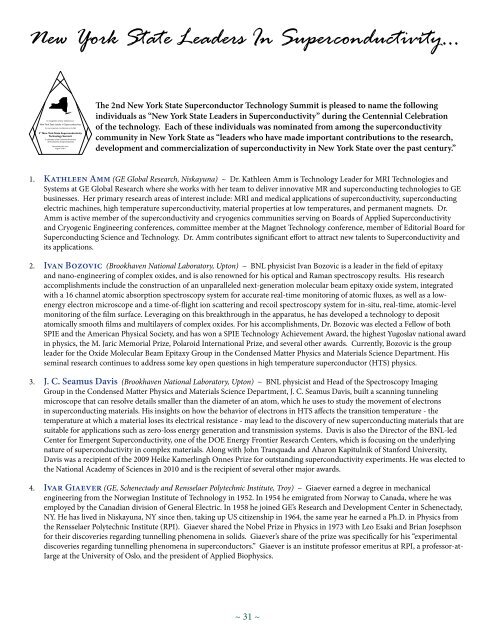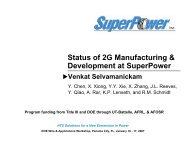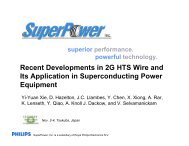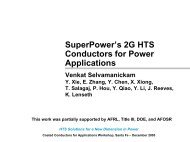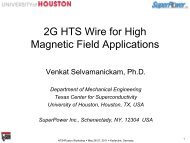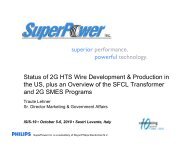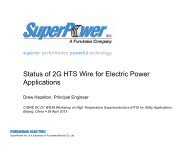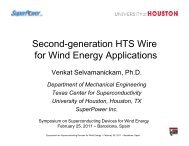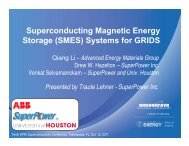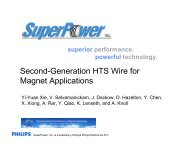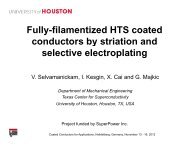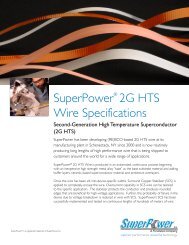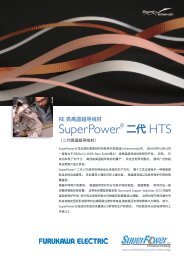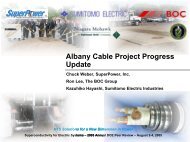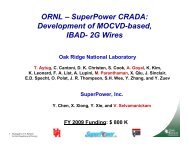New York State Leaders In Superconductivity... - SuperPower
New York State Leaders In Superconductivity... - SuperPower
New York State Leaders In Superconductivity... - SuperPower
You also want an ePaper? Increase the reach of your titles
YUMPU automatically turns print PDFs into web optimized ePapers that Google loves.
<strong>New</strong> <strong>York</strong> <strong>State</strong> <strong>Leaders</strong> <strong>In</strong> <strong>Superconductivity</strong>...<br />
The 2nd <strong>New</strong> <strong>York</strong> <strong>State</strong> Superconductor Technology Summit is pleased to name the following<br />
individuals as “<strong>New</strong> <strong>York</strong> <strong>State</strong> <strong>Leaders</strong> in <strong>Superconductivity</strong>” during the Centennial Celebration<br />
of the technology. Each of these individuals was nominated from among the superconductivity<br />
community in <strong>New</strong> <strong>York</strong> <strong>State</strong> as “leaders who have made important contributions to the research,<br />
development and commercialization of superconductivity in <strong>New</strong> <strong>York</strong> <strong>State</strong> over the past century.”<br />
1. Kathleen Amm (GE Global Research, Niskayuna) ~ Dr. Kathleen Amm is Technology Leader for MRI Technologies and<br />
Systems at GE Global Research where she works with her team to deliver innovative MR and superconducting technologies to GE<br />
businesses. Her primary research areas of interest include: MRI and medical applications of superconductivity, superconducting<br />
electric machines, high temperature superconductivity, material properties at low temperatures, and permanent magnets. Dr.<br />
Amm is active member of the superconductivity and cryogenics communities serving on Boards of Applied <strong>Superconductivity</strong><br />
and Cryogenic Engineering conferences, committee member at the Magnet Technology conference, member of Editorial Board for<br />
Superconducting Science and Technology. Dr. Amm contributes significant effort to attract new talents to <strong>Superconductivity</strong> and<br />
its applications.<br />
2. Ivan Bozovic (Brookhaven National Laboratory, Upton) ~ BNL physicist Ivan Bozovic is a leader in the field of epitaxy<br />
and nano-engineering of complex oxides, and is also renowned for his optical and Raman spectroscopy results. His research<br />
accomplishments include the construction of an unparalleled next-generation molecular beam epitaxy oxide system, integrated<br />
with a 16 channel atomic absorption spectroscopy system for accurate real-time monitoring of atomic fluxes, as well as a lowenergy<br />
electron microscope and a time-of-flight ion scattering and recoil spectroscopy system for in-situ, real-time, atomic-level<br />
monitoring of the film surface. Leveraging on this breakthrough in the apparatus, he has developed a technology to deposit<br />
atomically smooth films and multilayers of complex oxides. For his accomplishments, Dr. Bozovic was elected a Fellow of both<br />
SPIE and the American Physical Society, and has won a SPIE Technology Achievement Award, the highest Yugoslav national award<br />
in physics, the M. Jaric Memorial Prize, Polaroid <strong>In</strong>ternational Prize, and several other awards. Currently, Bozovic is the group<br />
leader for the Oxide Molecular Beam Epitaxy Group in the Condensed Matter Physics and Materials Science Department. His<br />
seminal research continues to address some key open questions in high temperature superconductor (HTS) physics.<br />
3. J. C. Seamus Davis (Brookhaven National Laboratory, Upton) ~ BNL physicist and Head of the Spectroscopy Imaging<br />
Group in the Condensed Matter Physics and Materials Science Department, J. C. Seamus Davis, built a scanning tunneling<br />
microscope that can resolve details smaller than the diameter of an atom, which he uses to study the movement of electrons<br />
in superconducting materials. His insights on how the behavior of electrons in HTS affects the transition temperature - the<br />
temperature at which a material loses its electrical resistance - may lead to the discovery of new superconducting materials that are<br />
suitable for applications such as zero-loss energy generation and transmission systems. Davis is also the Director of the BNL-led<br />
Center for Emergent <strong>Superconductivity</strong>, one of the DOE Energy Frontier Research Centers, which is focusing on the underlying<br />
nature of superconductivity in complex materials. Along with John Tranquada and Aharon Kapitulnik of Stanford University,<br />
Davis was a recipient of the 2009 Heike Kamerlingh Onnes Prize for outstanding superconductivity experiments. He was elected to<br />
the National Academy of Sciences in 2010 and is the recipient of several other major awards.<br />
4. Ivar Giaever (GE, Schenectady and Rensselaer Polytechnic <strong>In</strong>stitute, Troy) ~ Giaever earned a degree in mechanical<br />
engineering from the Norwegian <strong>In</strong>stitute of Technology in 1952. <strong>In</strong> 1954 he emigrated from Norway to Canada, where he was<br />
employed by the Canadian division of General Electric. <strong>In</strong> 1958 he joined GE’s Research and Development Center in Schenectady,<br />
NY. He has lived in Niskayuna, NY since then, taking up US citizenship in 1964, the same year he earned a Ph.D. in Physics from<br />
the Rensselaer Polytechnic <strong>In</strong>stitute (RPI). Giaever shared the Nobel Prize in Physics in 1973 with Leo Esaki and Brian Josephson<br />
for their discoveries regarding tunnelling phenomena in solids. Giaever’s share of the prize was specifically for his “experimental<br />
discoveries regarding tunnelling phenomena in superconductors.” Giaever is an institute professor emeritus at RPI, a professor-at-<br />
Iarge at the University of Oslo, and the president of Applied Biophysics.<br />
~ 31 ~
5. William E. and Peter E. Gifford (Cryomech, Syracuse) ~ Bill Gifford invented both the GM cycle and the Pulse<br />
Tube cycle more than 50 years ago. These inventions led to the development of cryogenic refrigeration systems with cooling<br />
capacities from 4K to 100K, ideal for use with the broad range of superconducting applications. <strong>In</strong> 1963, Bill founded Cryomech<br />
<strong>In</strong>c. in Syracuse, NY, while a professor at Syracuse University. <strong>In</strong> its early days, Cryomech consisted of Bill and a handful of part<br />
time employees, mainly graduate students. Under Bill’s tutelage, a number of these students went on to distinguished careers in<br />
the cryogenic field. Peter joined his father in 1973 and has led the company since Bill’s death in 1980. Over the past 30 plus years<br />
Cryomech has continued to be a leading innovator in the field of cryogenics. Under Peter’s leadership, Cryomech, still based in<br />
Syracuse, is a thriving, rapidly growing company with close to 100 employees. A number of Cryomech’s cryorefrigerators were<br />
specifically developed to meet the demands of the LTC and HTC superconductivity community.<br />
6. Ramesh Gupta (Brookhaven National Laboratory, Upton) ~ BNL has always been a leader in the world of superconducting<br />
magnets, which are essential to great modern accelerators such as the Relativistic Heavy Ion Collider at BNL, and the Large<br />
Hadron Collider at CERN, Switzerland. For the past decade, Lab researchers have been exploring the use of new materials that<br />
become superconducting at higher temperatures. Ramesh Gupta, head of the High Temperature Superconductor (HTS) Research<br />
and Development Group in the Superconducting Magnet Division, is among those exploring avenues for HTS magnets that are<br />
energy efficient and have magnetic fields that are a million times stronger than the Earth’s. These new magnets could revolutionize<br />
use in future accelerators, play a key role in energy efficiency and storage, and make possible new applications such as muon<br />
colliders and MRI screening in remote areas. To date, Gupta and his group have built more than 100 HTS coils and 10 HTS<br />
magnets using tens of kilometers of such conductors. Gupta is part of a team from the Condensed Matter Physics and Materials<br />
Science Department that recently received a grant from the Department of Energy’s Advanced Research Projects Agency-Energy<br />
(ARPA-E) to fund superconducting magnet energy storage research. The project, a collaboration with <strong>SuperPower</strong>, ABB <strong>In</strong>c. of<br />
Cary, NC, and the University of Houston, could have a significant impact on how electricity is stored and delivered in the future.<br />
7. Drew Hazelton (<strong>In</strong>termagnetics, Latham and <strong>SuperPower</strong>, Schenectady) ~ Mr. Hazelton joined <strong>In</strong>termagnetics in 1980 and<br />
has more than 30 years of experience in applied superconductivity. He has been with <strong>SuperPower</strong>, now a subsidiary of Philips,<br />
since its formation in 2000. His activities have included composite superconductor materials processing, mechanical properties<br />
and low temperature effects with emphasis on the development of processing for and application of superconducting materials.<br />
Mr. Hazelton has led development and demonstration programs in HTS cables, superconducting fault current limiters, HTS<br />
transformers, HTS generators, HTS magnets of all types and the superconducting magnetic energy storage system (SMES). Mr.<br />
Hazelton was named “Co-<strong>In</strong>ventor of the Year” in 2005 by the Eastern <strong>New</strong> <strong>York</strong> <strong>In</strong>tellectual Property Law Association for the<br />
US patent, 6,664,875 relating to the Matrix-type superconducting fault current limiter. Mr. Hazelton has a B.S. in Materials<br />
Engineering from Rensselaer Polytechnic <strong>In</strong>stitute and an M.S. in Mechanical Engineering from Union College.<br />
8. Richard Hitt (Hypres, Elmsford) ~ Mr. Hitt drove the development and demonstration of superconducting electronics<br />
prototypes which established the benefit and credibility of the technology with the DOD and triggered a press release from the<br />
US Army touting one of the demonstrations as “the most significant advance in Satellite Communications in thirty years.” He<br />
established the Hypres foundry as the premier and the only worldwide COMMERCIAL foundry for superconducting electronics,<br />
serving researchers in universities and corporate R&D centers worldwide. Hitt grew the small business through increased<br />
revenues leading to job creation of high skilled positions that grew the company by over 20% and added or saved more than 8 jobs<br />
in a 40-employee company in Westchester County, NY. He drove the collaborative activities with NY universities, research centers<br />
and private companies, leading to the creation of the new Centers for research and new joint research programs, with partners<br />
including Stony Brook University, The College for Nanoscale Science and Engineering (CNSE) at the University at Albany, and<br />
many of the companies represented at the current Summit.<br />
9. Peter Johnson (Brookhaven National Laboratory, Upton) ~ Dr. Johnson is a physicist at Brookhaven National Laboratory,<br />
Group Leader for Electron Spectroscopy, and Chair of the Condensed Matter Physics and Materials Science Department. He was<br />
recently a co-recipient of the American Physical Society’s prestigious 2011 Oliver E. Buckley Prize in Condensed Matter Physics for<br />
“innovation in angle-resolving photoemission spectroscopy, which advanced the understanding of the cuprate superconductors,<br />
and transformed the study of strongly correlated electronic systems.” Johnson has worked with various forms of photoemission<br />
spectroscopy, including inverse (time-reversed), spin-polarized, and high-resolution photoemission spectroscopy. It is this last<br />
variant for which he was honored. The techniques that Johnson helped develop have provided more insight than any other into one<br />
of the major challenges of modern physics, namely strongly correlated electronic materials, of which cuprate superconductors are<br />
one example. Johnson is a Fellow of the American Association for the Advancement of Science, the American Physical Society, and<br />
the <strong>In</strong>stitute of Physics in the United Kingdom.<br />
10. A. Kamal Kalafala (<strong>In</strong>termagnetics and Philips, Latham) ~ Dr. Kalafala has worked in superconductivity for more than<br />
30 years and is one of the world leaders in large scale applications of superconductivity. First at General Electric in Schenectady<br />
and then with <strong>In</strong>termagnetics (acquired by Philips in 2006), he successfully managed and made multiple technical contributions<br />
to such applications as MRI, SMES, crystal growth, Maglev and others. Among his most successful projects are the world first<br />
compact 3 Tesla magnet and 1.0 Tesla High-field open magnet for use in Magnetic Resonance Imaging.<br />
~ 32 ~
11. Mark Ketchen (IBM, Poughkeepsie) ~ Dr. Ketchen has been a pioneer in superconducting electronics from the early years<br />
of IBM’s involvement in the 1970s and 1980s. He has invented and implemented a number of innovative SQUID circuits and<br />
designs, many of which formed the basis of all SQUID applications today. Dr. Ketchen led many of the IBM efforts in advanced<br />
microcircuit design and fabrication and is a tireless advocate of superconductivity at IBM, in the state of NY, in the US and<br />
worldwide. He has won numerous awards and is recognized by his peers as one of the statesmen in the field. Dr. Ketchen is poised<br />
to play a leading role in any expected revival of superconducting electronics for high performance and high efficiency computing.<br />
12. Evangelos Trifon Laskaris (GE Global Research, Niskayuna) ~ Dr. Laskaris has had a long and impactful career in<br />
superconductivity. He has been a key inventor in almost every MRI magnet that GE has developed. He holds the largest number<br />
of patents of any researcher at GE Global Research and was named a member of the National Academy of Engineering in 2004<br />
for his pioneering contributions to the design and construction of superconducting magnets for MRI systems. He has taught and<br />
mentored many people in superconductivity over his long and continuing career at GE.<br />
13. Qiang Li (Brookhaven National Laboratory, Upton) ~ For a superconductor, charges need to be paired and moving coherently<br />
to carry a current with no resistance. The ‘stripe’ order suggests the charges are localized in relatively fixed positions. Brookhaven<br />
studies suggest that the presence of alternating stripes of magnetism and charge exist in other superconducting materials, in a way<br />
that is more fluid and therefore harder to detect. One of the key measurements, made by Brookhaven physicist Dr. Qiang Li, was<br />
of electrical resistance parallel to the planes of the layered material and also perpendicular to them. At a particular temperature,<br />
Li detected a big drop in resistance when the current was flowing parallel to the layers, but not when it was flowing perpendicular<br />
to them. More broadly, Li currently leads the Advanced Energy Materials Group in the Condensed Matter Physics and Materials<br />
Science Department that studies the microscopic and macroscopic properties of complex and nano-structured materials, including<br />
new superconductors, with a view to understanding and developing their application in different and real-world energy related<br />
technologies. Dr. Li is part of the BNL team that recently received a grant from the U.S. DOE’s Advanced Research Projects<br />
Agency-Energy (ARPA-E) to fund superconducting magnet energy storage research.<br />
14. Garry Morrow (<strong>In</strong>termagnetics General Corporation, Latham) ~ During his nearly 30-year tenure with <strong>In</strong>termagnetics,<br />
Mr. Morrow was instrumental in the development and marketing of very-high field Nb3Sn magnets (1970s), work on the first<br />
superconducting MRI magnets including actively-shielded and mobile MRI (1980s) and commercialization of MRI technology.<br />
Garry actively pursued new applications of superconductivity and was Vice President the MagStream division of IGC which<br />
involved utilizing superconductivity for magnetic separation of materials.<br />
15. Carl H. Rosner (GE, Schenectady; <strong>In</strong>termagnetics, Latham; CardioMag Imaging, Schenectady) ~ Mr. Rosner co-founded<br />
<strong>In</strong>termagnetics General Corporation (Guilderland and Latham, NY) in 1971, prior to which he was Manager of General Electric’s<br />
Superconductivie Products Operation in Schenectady. During his tenure with IGC, he led the company’s growth to more than 250<br />
employees and to the successful development of a number of applications of superconductivity, most notably superconducting<br />
magnets for MRI. Until 1999 he held the roles of Chairman, President and CEO of <strong>In</strong>termagnetics. That company was acquired by<br />
Philips in 2006. He retired from IGC as Chairman-Emeritus in 2002 to devote his full time to building and developing CardioMag<br />
Imaging. Mr. Rosner is a graduate of the Stockholm <strong>In</strong>stitute of Technology, <strong>New</strong>ark College of Engineering and Rensselaer<br />
Polytechnic <strong>In</strong>stitute with undergraduate and graduate degrees in electrical engineering and business management. He is a<br />
member of the National Academy of Engineering and is the author and co-author of many published papers on superconductive<br />
and electronic devices. He holds seven patents.<br />
16. William Sampson (Brookhaven National Laboratory, Upton) ~ A physicist in the Superconducting Magnet Division at BNL,<br />
Dr. Sampson has helped to design and build superconducting magnets that keep particle beams circulating in accelerators, such as<br />
Brookhaven’s Relativistic Heavy Ion Collider (RHIC). <strong>In</strong> the 1960s, he built some of the first superconducting magnets to exceed<br />
10 Tesla, 200,000 times the earth’s magnetic field. Sampson also made early models of dipole and quadrupole magnets, used for<br />
bending and focusing beams of particles in accelerators. Accelerators around the world, including RHIC and the Large Hadron<br />
Collider (LHC) at CERN, have benefited from this pioneering work. <strong>In</strong> the 1970s, Sampson made magnets called “wigglers”<br />
for the National Synchrotron Light Source, which began operating in 1982. Sampson has also worked on HTS magnets that can<br />
operate in high radiation environments. Currently, Sampson is developing very high-field superconducting magnets that may be<br />
used in building a high-energy muon collider. He has received the IEEE Council on <strong>Superconductivity</strong> Award for Significant and<br />
Sustained Contributions in the Field of Applied <strong>Superconductivity</strong>, in particular, for his contributions to the field of large-scale<br />
superconductivity<br />
~ 33 ~
17. Venkat Selvamanickam (<strong>In</strong>termagnetics, Latham and <strong>SuperPower</strong>, Schenectady) ~ Dr. Selvamanickam (“Selva”) joined<br />
<strong>In</strong>termagnetics General Corporation in 1994 and was instrumental in establishing the <strong>SuperPower</strong> subsidiary in March 2000,<br />
initially as Program Manager, Materials Technology where he led a team of more than 40 scientists, engineers and technicians<br />
engaged in scaling up to manufacture <strong>SuperPower</strong>’s 2G HTS wire, and then as Vice President and CTO. Selva has authored more<br />
than 100 U.S. and international patents and more than 100 publicaitons on HTS. Prior to joining IGC, he was a Research Associate<br />
at Oak Ridge National Laboratory; and a Post-doctoral fellow and Research Assistant with the Texas Center for <strong>Superconductivity</strong><br />
at the University of Houston. <strong>In</strong> 1996, Dr. Selvamanickam received the Presidential Early Career Award from the White House.<br />
This award is the highest honor bestowed by the U.S. Government on outstanding scientists and engineers beginning their<br />
independent careers. The award resulted in a grant of $500,000 for five years to conduct research on HTS in collaboration with the<br />
U.S. Air Force. <strong>In</strong> 2005, Dr. Selvamanickam was named the “<strong>Superconductivity</strong> <strong>In</strong>dustry Person of the Year” by Superconductor<br />
Week. He earned a Ph.D. in Materials Engineering and an M.S. in Mechanical Engineering from the University of Houston. Dr.<br />
Selvamanickam continues to lead <strong>SuperPower</strong>’s R&D program as Chief Technology Advisor, while also holding the position of<br />
W.D. Anderson Chair Professor in the Department of Mechanical Engineering at the University of Houston.<br />
18. Vasili Semenov (IBM, Poughkeepsie and Stony Brook University, Stony Brook) ~ Dr. Semenov is a co-inventor of rapid single<br />
flux quantum electronics which has been the key to getting beyond the limitation of latching logic that had formed the basis of the<br />
early efforts in supercomputers. More recently, Dr. Semenov innovated yet another approach to achieving the fundamental limit<br />
in low energy dissipation in high end computation, particular in reversible computing. Dr. Semenov has been the key academic<br />
leader in <strong>New</strong> <strong>York</strong> <strong>State</strong> to advise graduate students and postdoctoral associates who then go on to become part of the workforce<br />
in the state for the further development and commercialization of superconductor electronics. <strong>In</strong>novator, educator, teacher to<br />
colleagues as well as students, Dr. Semenov expemplifies the scientific thought leader that guides our field and its applications in<br />
electronics.<br />
19. <strong>SuperPower</strong> Team (Schenectady) ~ <strong>SuperPower</strong> is a world leader in the manufacturing scale-up of HTS wire, an important<br />
technology addressing the quest for improved energy efficiency. <strong>SuperPower</strong> is a high performing business that is also developing<br />
advanced devices for Clean, Green, and Smart Grid applications. The company is a true community partner and works closely<br />
with Schenectady County Community College to develop and implement a quality nanotechnology career program to respond to<br />
an emerging workforce need. This has included curriculum development and teaching of the advanced level courses. The team<br />
also works with Union College and Union Graduate College to incorporate the technology into the engineering and management<br />
programs at those institutions. Special recognition to team members Art Kazanjian, Trudy Lehner, Gene Carota, Karol Zdun,<br />
Simon Miner and, in memoriam, Dr. Andrei Rar.<br />
20. Elie Track (Hypres, Elmsford) ~ For 24 years, Dr. Track has been dedicated to the development and commercialization of<br />
superconducting electronics, spanning all activities from hands-on laboratory work in device physics, to program management, to<br />
leading the successful effort of commercializing the NIST design of primary voltage standards and making it available worldwide.<br />
From Hypres’ home in Westchester County, NY, he led the electronics program of the Applied <strong>Superconductivity</strong> Conference,<br />
the main conference in the field, for many years, and emerged as the current leader of the field within IEEE, and as President of<br />
the IEEE Council on <strong>Superconductivity</strong> since the beginning of 2011. Perhaps most importantly, his ability to network together<br />
universities, companies, research institutions, and government agencies for the common goal of advancing the technology and<br />
markets of superconductivity has given the field much needed energy and boost over the last two decades.<br />
21. John Tranquada (Brookhaven National Laboratory, Upton) ~ Based on his neutron-scattering experiments in the 1980s<br />
at BNL’s High Flux Beam Reactor, Dr. Tranquada, a Brookhaven physicist, discovered that cuprates exhibit antiferromagnetism,<br />
a condition in which adjacent magnetic atoms have their magnetic north poles pointing in opposite directions. <strong>In</strong> the 1990s,<br />
Tranquada and his colleagues discovered that HTS have a tendency toward charge segregation, which enables the coexistence of<br />
conducting and insulating properties. This work indicates that the electronic structure of HTS consists of fluctuating strings of<br />
charge, known as stripes, a concept that is increasingly influencing the current models of HTS. Currently, he leads the Neutron<br />
Scattering Group in the Condensed Matter Physics and Materials Science Department. He was co-recipient of the 2009 Heike<br />
Kamerlingh Onnes Prize for outstanding superconductivity experiments. He is a Fellow of the American Physical Society and the<br />
American Association for the Advancement of Science. Tranquada received a U.S. Department of Energy Award for Outstanding<br />
Scientific Accomplishment in Solid <strong>State</strong> Physics in 1988 and the Sustained Research Prize from the Neutron Scattering Society of<br />
America in 2006.<br />
~ 34 ~
22. Peter Wanderer (Brookhaven National Laboratory, Upton) ~ Dr. Wanderer is an expert in the development of<br />
superconducting accelerator magnets. He began working on them for the Isabelle Project. His magnet work continued with the<br />
Colliding Beam Accelerator, the Superconducting SuperCollider (SSC), the Relativistic Heavy Ion Collider (RHIC), the Large<br />
Hadron Collider (LHC), the LHC Accelerator Research Program (LARP), the Accelerator Project Upgrade for the LHC (APUL),<br />
and other projects. During the SSC and RHIC projects, he was head of the Magnet Test Group. For the RHIC Project, he cochaired<br />
the Magnet Acceptance Committee. He is currently the Project Manager for the APUL Project and <strong>In</strong>terim Head of<br />
the Superconducting Magnet Division. As an example of the projects with which he has been affiliated, BNL was a key player<br />
in preparing a new material for use in a focusing magnet built by members of the multilaboratory LHC Accelerator Research<br />
Program (LARP). The material, niobium tin retains its superconducting properties at higher temperatures than niobium titanium,<br />
the material that’s used in RHIC and in today’s LHC magnets, making it more tolerant of the increased beam heating that will<br />
accompany increases in the LHC luminosity. <strong>In</strong> 2009, a magnet built by the LARP team using superconducting niobium tin<br />
achieved the goal of a magnetic field strong enough to focus intense proton beams in the upgraded LHC interaction regions.<br />
Wanderer led the effort during its most critical phase.<br />
23. Robert Wilcox (<strong>In</strong>termagnetics and Philips, Latham) - Mr. Wilcox retired 2 years ago after almost 35 years with<br />
<strong>In</strong>termagnetics / Philips. For many years, he was Manager of Magnet Engineering and Director of Engineering. Bob Wilcox made<br />
outstanding technical contributions to all <strong>In</strong>termagnetics/Philips products for variety of industrial, research, medical and military<br />
applications. More than 20 commercial superconducting magnets were designed under his leadership and supervision. Without<br />
Bob’s involvement, it is difficult to imagine <strong>In</strong>termagnetics’ commercial superconducting MRI magnets.<br />
~ 35 ~


